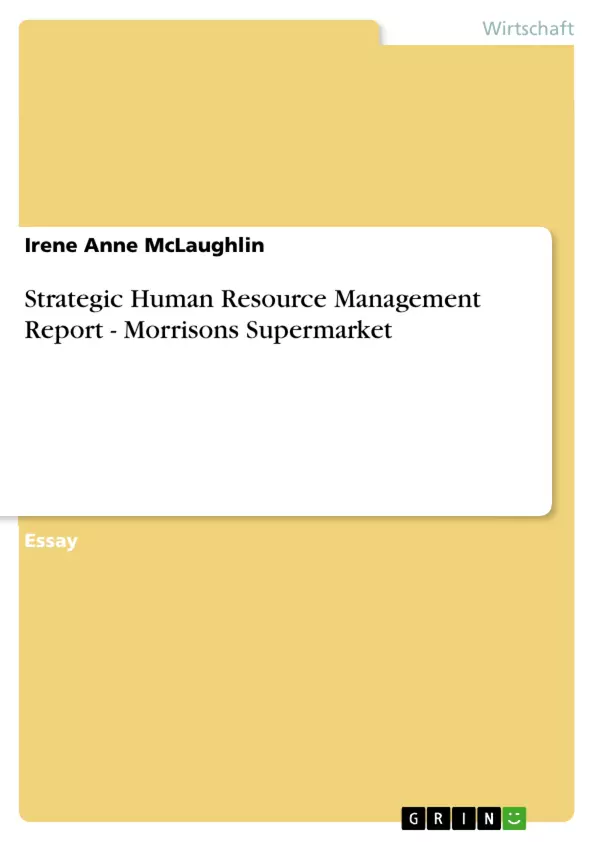This report shows an overview and analysis identifying the current SHRM and business strategies by Morrisons. Further analysis reviews employees comments in comparison to the propounded corporate strategies and recommendations are made to improve and operationalise the proposals.
Inhaltsverzeichnis
- Executive Summary
- Theory
- Morrisons Company Profile
- Morrisons SHRM History
- Identifying Core SHRM Strategies at Morrisons
- Current HR Technology
- Recruitment and Selection Strategies
- Reward system strategy
- Training, Development and Talent Management
- Trade Union Position
- Conclusions on Biggest SHRM Issues
- Morrisons Current Business Strategies
- Critical Analysis Using Porter's Model
- Morrisons Pestel and SWOT Analysis
- Conclusions on Biggest Strategic Issues
- Identification of relevant regulatory factors that impact Morrisons and HRM practice in general
- Environmental factors that might impact Morrisons' HRM practices
- Recommendations for Morrisons regarding the Strategies they should be pursuing
- Recommendations on how these strategies could be operationalised
- Conclusions
Zielsetzung und Themenschwerpunkte
Dieser Bericht analysiert die aktuellen Strategien im strategischen Personalmanagement (SHRM) und im Geschäftsbereich von Morrisons. Er vergleicht Mitarbeiterfeedback mit den publizierten Unternehmensstrategien und gibt Empfehlungen zur Verbesserung und Umsetzung der Vorschläge. Der Fokus liegt auf der Diskrepanz zwischen rhetorisch formulierten Zielen und der Realität.
- Analyse der SHRM-Strategie von Morrisons
- Vergleich von Mitarbeiterfeedback mit Unternehmensstrategien
- Bewertung der aktuellen HR-Technologie und -Systeme
- Untersuchung von Rekrutierungs- und Auswahlstrategien
- Analyse der Personalentwicklung und des Talentmanagements
Zusammenfassung der Kapitel
Executive Summary: Diese Zusammenfassung bietet einen Überblick über den Bericht und hebt die Analyse der aktuellen SHRM- und Geschäftsstrategien von Morrisons hervor. Sie kündigt den Vergleich von Mitarbeiterkommentaren mit den Unternehmensstrategien und die daraus resultierenden Empfehlungen an.
Theory: Dieses Kapitel legt die theoretischen Grundlagen des strategischen Personalmanagements (SHRM) dar. Es betont die Bedeutung der Einbindung aller Führungskräfte und die Notwendigkeit, dass SHRM die Erreichung der Unternehmensziele und die Umsetzung der Unternehmenswerte sicherstellt. Es wird auf die potenzielle Diskrepanz zwischen rhetorischer Darstellung und tatsächlicher Umsetzung hingewiesen.
Morrisons Company Profile: Dieses Kapitel beschreibt Morrisons als viertgrößtes Supermarkt-Unternehmen im Vereinigten Königreich, mit einem komplexen Geschäftsmodell und einer großen Mitarbeiterzahl. Es werden die vier Schwerpunktbereiche des Unternehmens (2009: Werte, Talent, Performance, Leadership; 2014: Beziehungen, Kundenservice, Engagiertere Mitarbeiter, Bindung & Anwesenheit, Talentgewinnung, Produktivität) und die Herausforderungen im Zusammenhang mit der Personalführung angesichts von Führungswechseln und negativer Berichterstattung beleuchtet.
Morrisons SHRM History: Dieses Kapitel beschreibt die Entwicklung der Personalabteilung bei Morrisons von einem rein administrativen Personalteam hin zu einer nach dem Ulrich-Modell strukturierten HR-Abteilung. Es behandelt die Herausforderungen durch Unternehmenszukäufe (Safeway, Somerfield) und die daraus resultierenden Kulturunterschiede sowie den Mangel an etablierten HR-Systemen in Bereichen wie Talentmanagement und Performance Management.
Identifying Core SHRM Strategies at Morrisons: Dieses Kapitel analysiert zentrale SHRM-Strategien von Morrisons. Es beleuchtet die Probleme mit veralteter HR-Technologie (HRizon-Projekt), die Rekrutierungs- und Selektionsstrategien (mit Hinweis auf Personalmangel), das Vergütungssystem (mit Kritik an der Bezahlung von Mitarbeitern im Verkauf), die Personalentwicklung und das Talentmanagement (mit Fokus auf den Unterschied zwischen HQ- und Filialmitarbeitern), sowie die Rolle der Gewerkschaft USDAW.
Schlüsselwörter
Strategisches Personalmanagement (SHRM), Morrisons, Mitarbeiterfeedback, HR-Technologie, Rekrutierung, Talentmanagement, Personalentwicklung, Gewerkschaft USDAW, Unternehmensstrategie, Mitarbeiterzufriedenheit, Unternehmenskultur.
Häufig gestellte Fragen zum Morrisons SHRM-Bericht
Was ist der Gegenstand dieses Berichts?
Dieser Bericht analysiert die aktuellen Strategien im strategischen Personalmanagement (SHRM) und im Geschäftsbereich des britischen Supermarktriesen Morrisons. Er vergleicht intern gesammeltes Mitarbeiterfeedback mit den öffentlich kommunizierten Unternehmensstrategien und gibt konkrete Empfehlungen zur Verbesserung und Umsetzung der Personalstrategie.
Welche Aspekte des strategischen Personalmanagements werden untersucht?
Der Bericht untersucht umfassend verschiedene SHRM-Bereiche bei Morrisons, darunter die aktuelle HR-Technologie, Rekrutierungs- und Auswahlstrategien, das Vergütungssystem, die Personalentwicklung und das Talentmanagement, sowie die Rolle der Gewerkschaft USDAW. Ein besonderes Augenmerk liegt auf der Diskrepanz zwischen den rhetorisch formulierten Zielen und der tatsächlichen Umsetzung.
Wie wird die Analyse durchgeführt?
Die Analyse vergleicht Mitarbeiterfeedback mit den publizierten Unternehmensstrategien. Es wird eine kritische Betrachtung der aktuellen HR-Systeme und -Prozesse vorgenommen, unter anderem mithilfe von Modellen wie dem Porter's Five Forces Modell und einer PESTEL- sowie SWOT-Analyse. Die Bewertung basiert auf der Identifizierung relevanter regulatorischer und umweltbedingter Faktoren, die Morrisons und die HRM-Praxis im Allgemeinen beeinflussen.
Welche konkreten Themen werden im Bericht behandelt?
Der Bericht deckt ein breites Spektrum an Themen ab, darunter Morrisons' Unternehmens- und SHRM-Geschichte, die Identifizierung zentraler SHRM-Strategien, eine Analyse der aktuellen Geschäftsstrategien, sowie Empfehlungen zur Verbesserung der Strategien und deren Umsetzung. Die Kapitel behandeln unter anderem die HR-Technologie (HRizon-Projekt), Rekrutierung und Selektion, das Vergütungssystem, Personalentwicklung und Talentmanagement, sowie die Rolle der Gewerkschaft.
Wer sollte diesen Bericht lesen?
Dieser Bericht richtet sich an alle, die sich für strategisches Personalmanagement, insbesondere im Einzelhandel, interessieren. Er ist besonders relevant für Führungskräfte bei Morrisons, Personalmanager, Wissenschaftler und Studenten, die sich mit SHRM-Strategien und deren Umsetzung auseinandersetzen.
Welche Schlussfolgerungen zieht der Bericht?
Der Bericht kommt zu Schlussfolgerungen über die größten Herausforderungen im SHRM und im Geschäftsbereich von Morrisons. Er identifiziert Diskrepanzen zwischen den angestrebten Zielen und der Realität und liefert konkrete Handlungsempfehlungen zur Verbesserung der SHRM-Strategien und deren operativen Umsetzung. Die Schlussfolgerungen berücksichtigen sowohl interne Mitarbeiterperspektiven als auch externe Faktoren.
Welche Empfehlungen werden ausgesprochen?
Der Bericht gibt detaillierte Empfehlungen für Morrisons bezüglich der zu verfolgenden Strategien und deren operativen Umsetzung. Diese Empfehlungen basieren auf den im Bericht identifizierten Schwachstellen und den Ergebnissen der durchgeführten Analysen. Die Vorschläge zielen darauf ab, die Effektivität des strategischen Personalmanagements zu steigern und die Unternehmensziele besser zu erreichen.
Welche Schlüsselwörter beschreiben den Bericht am besten?
Schlüsselwörter sind: Strategisches Personalmanagement (SHRM), Morrisons, Mitarbeiterfeedback, HR-Technologie, Rekrutierung, Talentmanagement, Personalentwicklung, Gewerkschaft USDAW, Unternehmensstrategie, Mitarbeiterzufriedenheit, Unternehmenskultur.
- Citar trabajo
- Irene Anne McLaughlin (Autor), 2016, Strategic Human Resource Management Report - Morrisons Supermarket, Múnich, GRIN Verlag, https://www.grin.com/document/336023



